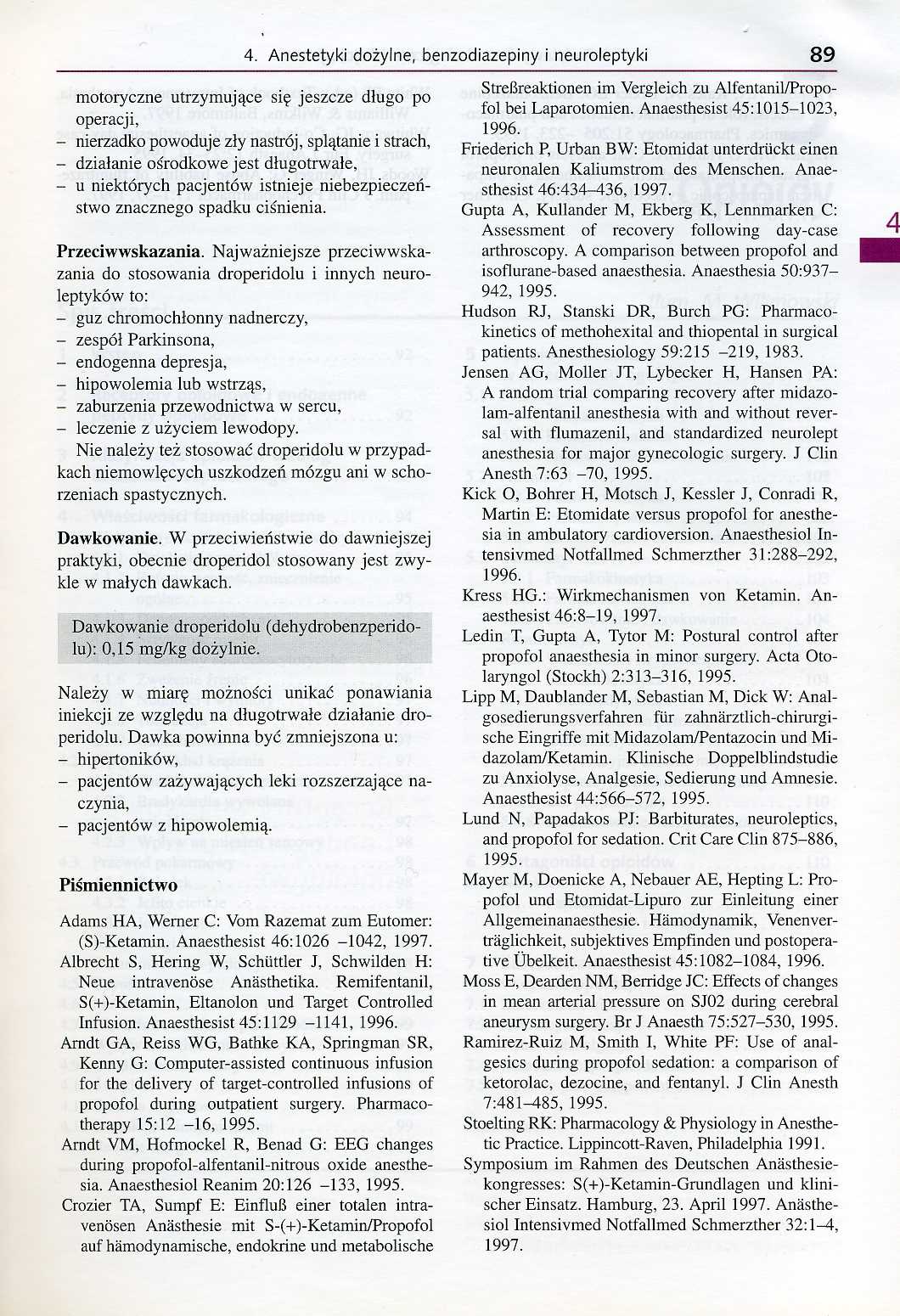larsen0089

4. Anestetyki dożylne, benzodiazepiny i neuroleptyki 89
motoryczne utrzymujące się jeszcze długo po operacji,
- nierzadko powoduje zly nastrój, splątanie i strach,
- działanie ośrodkowe jest długotrwałe,
- u niektórych pacjentów istnieje niebezpieczeństwo znacznego spadku ciśnienia.
Przeciwwskazania. Najważniejsze przeciwwskazania do stosowania droperidolu i innych neuroleptyków to:
- guz chromochłonny nadnerczy,
- zespół Parkinsona,
- endogenna depresja,
- hipowolemia lub wstrząs,
- zaburzenia przewodnictwa w sercu,
- leczenie z użyciem lewodopy.
Nie należy też stosować droperidolu w przypadkach niemowlęcych uszkodzeń mózgu ani w schorzeniach spastycznych.
Dawkowanie. W przeciwieństwie do dawniejszej praktyki, obecnie droperidol stosowany jest zwykle w małych dawkach.
Dawkowanie droperidolu (dehydrobenzperido-lu): 0,15 mg/kg dożylnie.
Należy w miarę możności unikać ponawiania iniekcji ze względu na długotrwałe działanie droperidolu. Dawka powinna być zmniejszona u:
- hipertoników,
- pacjentów zażywających leki rozszerzające naczynia,
- pacjentów z hipowolemią.
Piśmiennictwo
Adams HA, Werner C: Vom Razemat zum Eutomer: (S)-Ketamin. Anaesthesist 46:1026 -1042, 1997. Albrecht S, Hering W, Schiittler J, Schwilden H: Neue intravenóse Anasthetika. Remifentanil, S(+)-Ketamin, Eltanolon und Target Controlled Infusion. Anaesthesist 45:1129 -1141, 1996. Arndt GA, Reiss WG, Bathke KA, Springman SR, Kenny G: Computer-assisted continuous infusion for the delivery of target-controlled infusions of propofol during outpatient surgery. Pharmaco-therapy 15:12 -16, 1995.
Arndt VM, Hofmockel R, Benad G: EEG changes during propofol-alfentanil-nitrous oxide anesthe-sia. Anaesthesiol Reanirn 20:126 -133, 1995. Crozier TA, Sumpf E: EinfluB einer totalen intra-venosen Anasthesie mit S-(+)-Ketamin/Propofol auf hamodynamische, endokrine und metabolische
StreBreaktionen im Vergleich zu Alfentanil/Propo-fol bei Laparotomien. Anaesthesist 45:1015-1023, 1996.
Friederich P, Urban BW: Etomidat unterdriickt einen neuronalen Kaliumstrom des Menschen. Anaesthesist 46:434-436, 1997.
Gupta A, Kullander M, Ekberg K, Lennmarken C: Assessment of recovery following day-case arthroscopy. A comparison between propofol and isoflurane-based anaesthesia. Anaesthesia 50:937-942, 1995.
Hudson RJ, Stanski DR, Burch PG: Pharmaco-kinetics of methohexital and thiopental in surgical patients. Anesthesiology 59:215 -219, 1983.
Jensen AG, Molier JT, Lybecker H, Hansen PA: A random trial comparing recovery after midazo-lam-alfentanil anesthesia with and without rever-sal with flumazenil, and standardized neurolept anesthesia for major gynecologic surgery. J Clin Anesth 7:63 -70, 1995.
Kick O, Bohrer H, Motsch J, Kessler J, Conradi R, Martin E: Etomidate versus propofol for anesthesia in ambulatory cardioversion. Anaesthesiol In-tensivmed Notfallmed Schmerzther 31:288-292,
1996.
Kress HG.: Wirkmechanismen von Ketamin. Anaesthesist 46:8-19, 1997.
Ledin T, Gupta A, Tytor M: Postura! control after propofol anaesthesia in minor surgery. Acta Oto-laryngol (Stockh) 2:313-316, 1995.
Lipp M, Daublander M, Sebastian M, Dick W: Anal-gosedierungsverfahren fur zahnarztlich-chirurgi-sche Eingriffe mit Midazolam/Pentazocin und Mi-dazolam/Ketamin. Klinische Doppelblindstudie zu Anxiolyse. Analgesie, Sedierung und Amnesie. Anaesthesist 44:566-572, 1995.
Lund N, Papadakos PJ: Barbiturates, neuroleptics, and propofol for sedation. Crit Care Clin 875-886, 1995.
Mayer M, Doenicke A, Nebauer AE, Hepting L: Propofol und Etomidat-Lipuro zur Einleitung einer Allgemeinanaesthesie. Hamodynamik, Venenver-traglichkeit, subjektives Empfinden und postopera-tive Ubelkeit. Anaesthesist 45:1082-1084, 1996.
Moss E, Dearden NM, Berridge JC: Effects of changes in mean arterial pressure on SJ02 during cerebral aneurysm surgery. Br J Anaesth 75:527-530. 1995.
Ramirez-Ruiz M, Smith I, White PF: Use of anal-gesics during propofol sedation: a comparison of ketorolac, dezocine, and fentanyl. J Clin Anesth 7:481—485, 1995.
Stoelting RK: Pharmacology & Physiology in Anesthe-tic Practice. Lippincott-Raven, Philadelphia 1991.
Symposium im Rahmen des Deutschen Anasthesie-kongresses: S(+)-Ketamin-Grundlagen und klini-scher Einsatz. Hamburg, 23. April 1997. Anasthe-siol Intensivmed Notfallmed Schmerzther 32:1^1.
1997.
Wyszukiwarka
Podobne podstrony:
larsen0067 4. Anestetyki dożylne, benzodiazepiny i neuroleptyki 67 H O I &nb
larsen0069 4. Anestetyki dożylne, benzodiazepiny i neuroleptyki 692.2.4 Czynność nerek Ukrwienie ner
larsen0071 4. Anestetyki dożylne, benzodiazepiny i neuroleptyki 71 szych stężeniach dochodzi nawet d
larsen0073 4. Anestetyki dożylne, benzodiazepiny i neuroleptyki 732.8.1 Praktyczne postępowanie przy
larsen0075 4. Anestetyki dożylne, benzodiazepiny i neuroleptyki 75 jeżeli pacjent oddycha powietrzem
larsen0077 4. Anestetyki dożylne, benzodiazepiny i neuroleptyki 77 4.2.5 Synteza kortyzolu W przeciw
larsen0079 4. Anestetyki dożylne, benzodiazepiny i neuroleptyki 79 normy. Nasilenie tachykardii i po
larsen0081 4. Anestetyki dożylne, benzodiazepiny i neuroleptyki 81 - dawkowanie pr
larsen0083 4. Anestetyki dożylne, benzodiazepiny i neuroleptyki 836.2 Działania farmakologiczne Wszy
larsen0085 4. Anestetyki dożylne, benzodiazepiny i neuroleptyki 85 Tabela 4.7 Parametry farmakokin
larsen0087 4. Anestetyki dożylne, benzodiazepiny i neuroleptyki 87 nowych oraz wypiera z nich kompet
larsen0065 4Anestetyki dożylne, benzodiazepiny i neuroleptyki Spis treścittum. M. Wilimowski 1
226 227 Zwrot ku sobie Rozluźnienie wprowadza nas w pewnego rodzaju trans, który może utrzymywać sie
PIŁKA NOŻNA Drużyna Silesii Lubomia utrzymała się w lidze okręgowej po wygraniu baraży z Piastem
n12 (6) 172 Myślenie systemowe Jeśli dynamika taka utrzymuje się zbyt długo, ostatecznie również cał
instrukcja 009 Zaleca się włączanie biegu jałowego w chwili, gdy motorynka znajduje się jeszcze w ru
larsen1095 39. Znieczulenie u dzieci 10954.6.5 Desfluran Desfluran cechuje się jeszcze niższym współ
Nartowska Różnice indywidualne0057 ności, niegraficznych, angażujących te same funkcje. Stadium rysu
więcej podobnych podstron